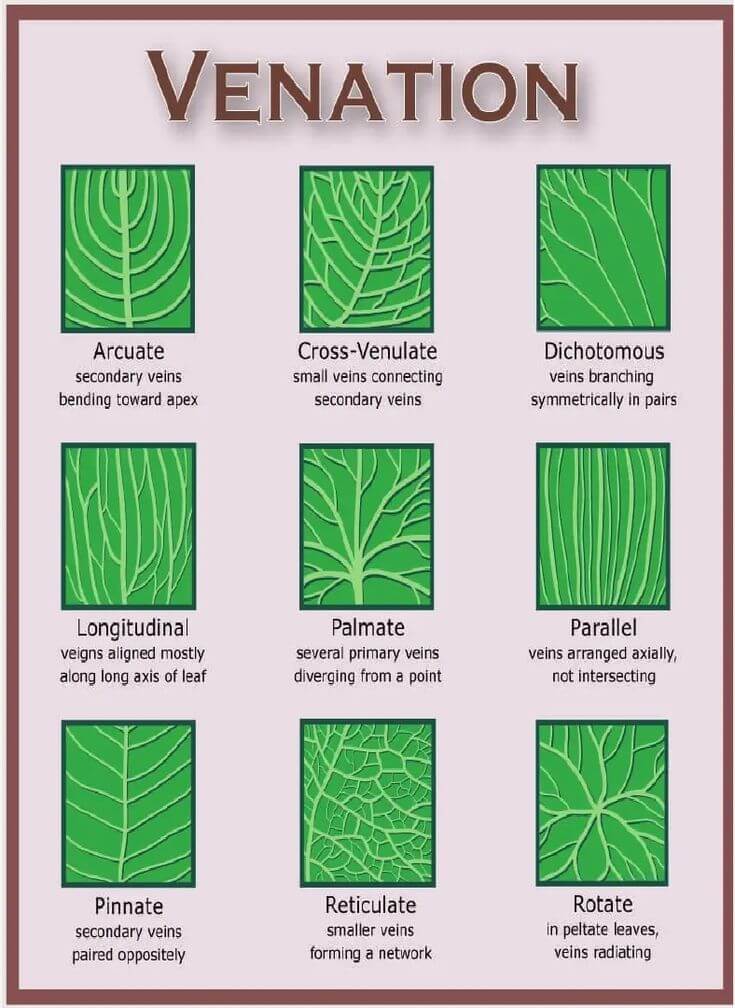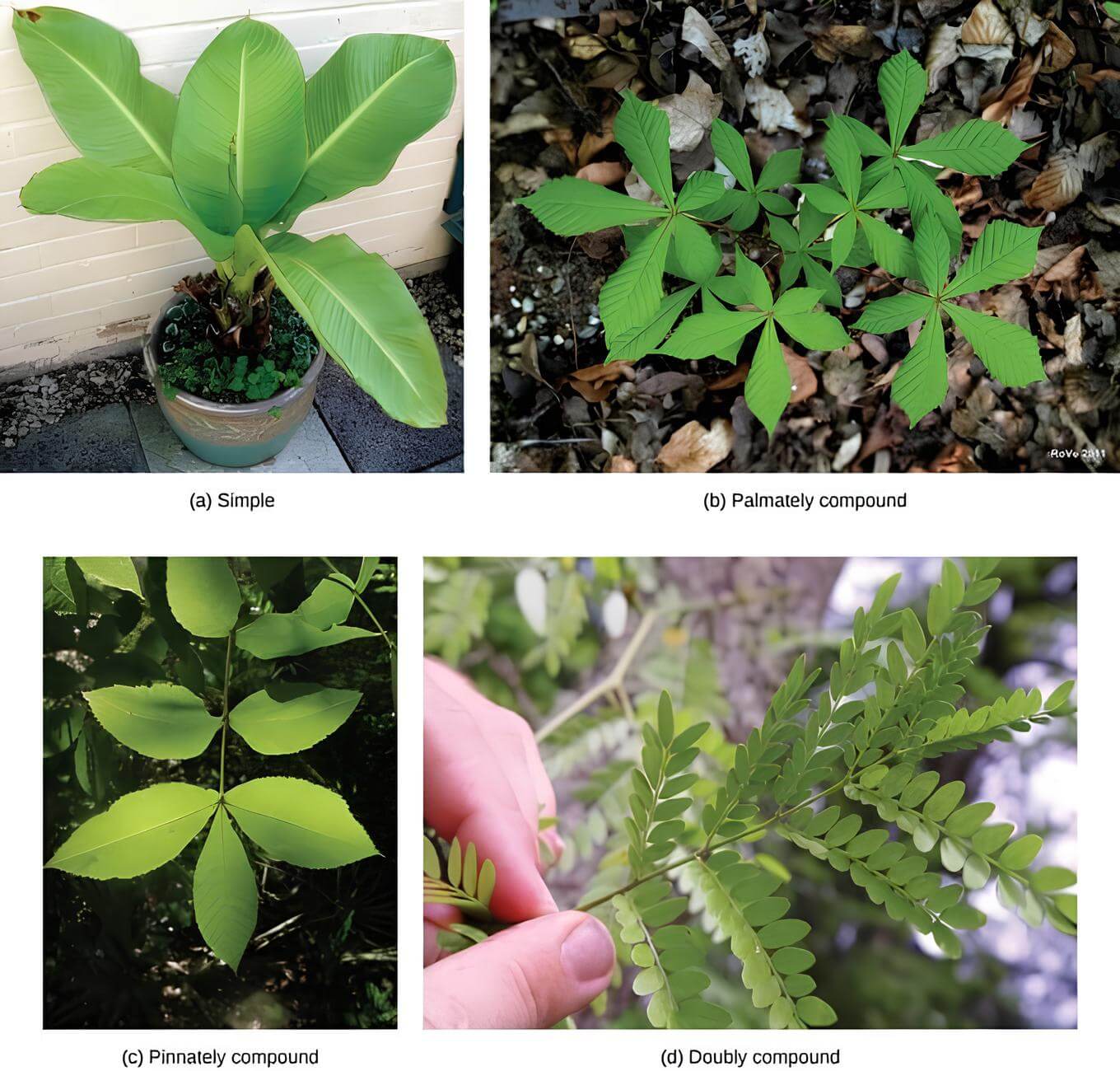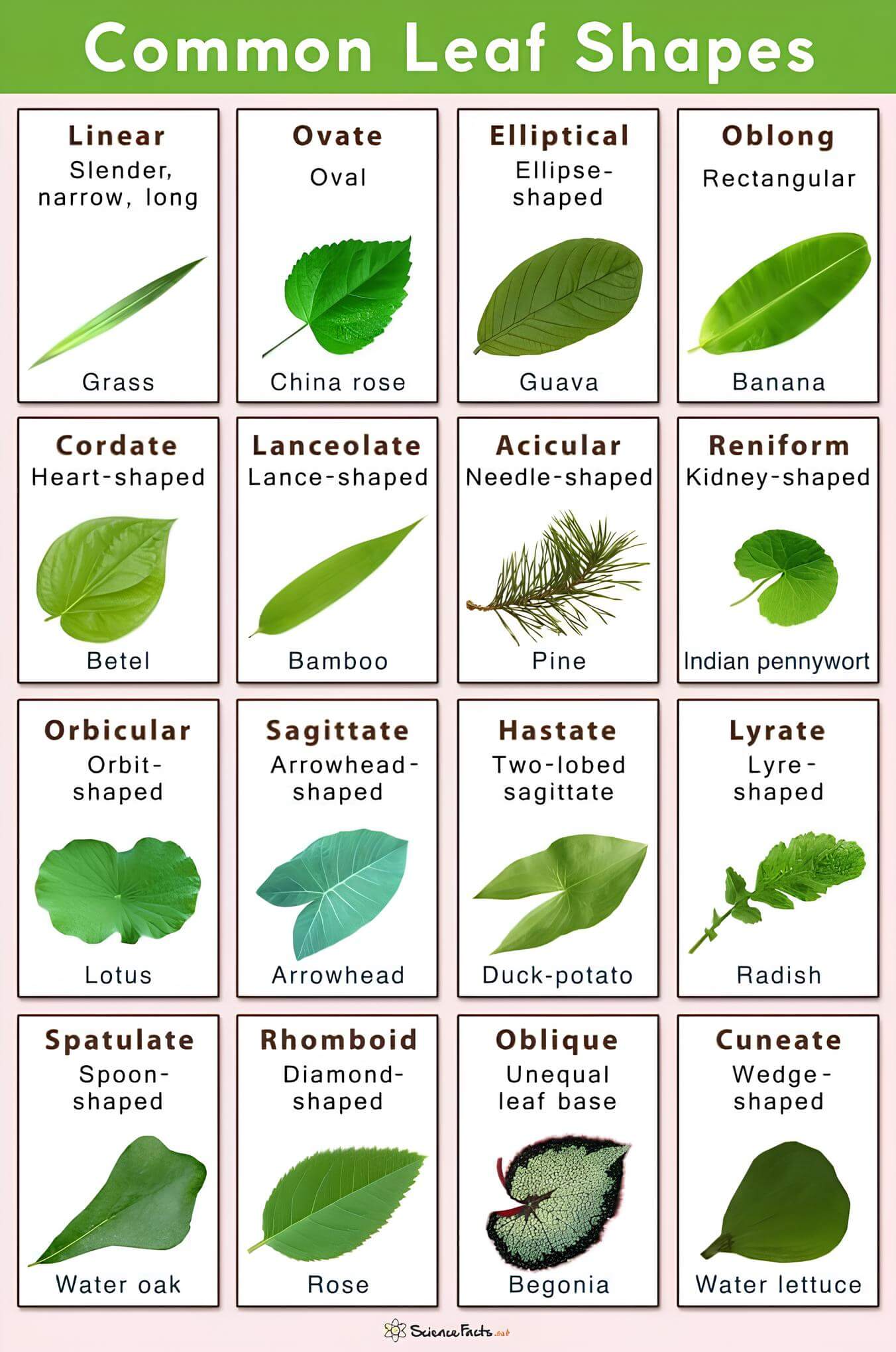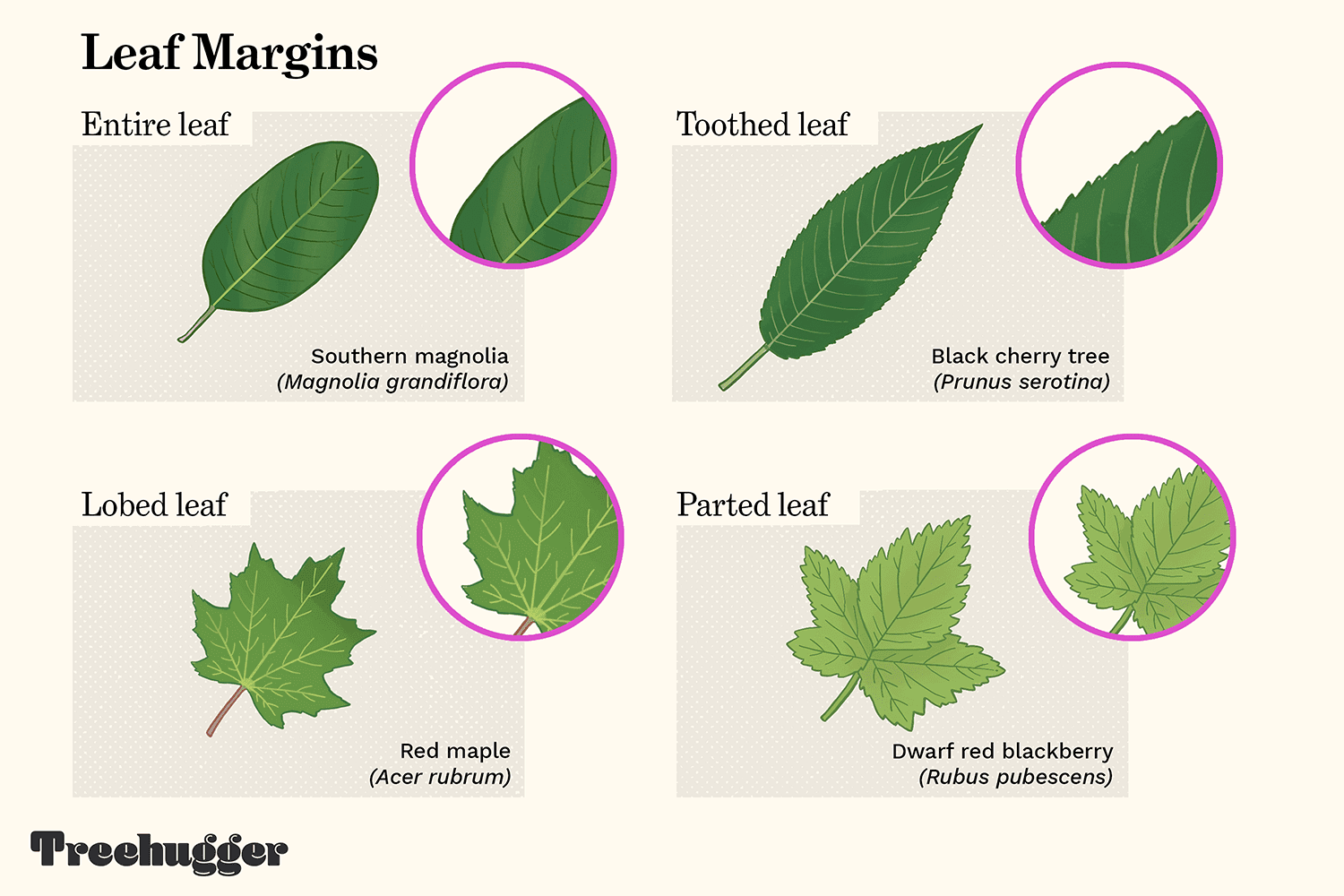Have you ever walked through a park or a garden and wondered about the names of all the different types of leaves you see? Each leaf has its own unique signature. Some are big, and some are small.
By examining characteristics such as shape, margin, venation, and arrangement, individuals can develop a keen eye for detail and enhance their understanding of the vegetative world around them.
In this friendly guide, we’re going to walk through some easy steps to help you recognize various types of leaves.
We’ll look at things like shape, edge, size, and color – all the clues that Mother Nature provides to help us identify her green treasures
Structure of a Leaf
Before getting into the details and all the technical jargon related to leaves and their parts, we must understand the structure of a leaf.
Leaves are the kitchen of the plant. A leaf can broadly be divided into two parts: the leaf blade and the petiole.
The leaf blade, also called the lamina, is broad and flat. This is where photosynthesis occurs.
There is a midrib that goes all the way in the middle, through which other branches arise. These are called veins.
Veins can be of different types depending on the number of blades and pattern of veins. The petiole is a stalk-like structure that connects the leaf to the branch.
It is composed of tiny tubes that connect the veins to the stem. They also enable water transport to the leaf from the roots.
Some plants may also have stipules, flap-like structures that grow at the base of the petiole. It is helpful in tree leaf identification.
What is Venation?

As mentioned earlier, the pattern of veins is different for different kinds of leaves. This arrangement is called venation.
Venation can be of three types: parallel, pinnate, and palmate. Parallel venation occurs when veins are arranged parallel to each other.
These veins are smaller and run lengthwise on the leaf. Pinnately veined leaves are composed of the main vein in the middle of the leaf with small branches of veins, just like a feather.
Palmately-veined leaves have many principal veins that branch out from the main midrib. You will have to take a close look at the leaves if you wish to identify the leaf from veins.
Leaf Identification Based on Arrangement
Known as phyllotaxy in botanical language, leaf arrangement on the stem can be an indicator of the tree. It is also a method for tree leaf identification.
The most common categories of leaf arrangement are simple and compound leaves.
Simple Leaves
A simple leaf is called simple because it is the simplest form of a leaf. The leaf is joined to the stem through the petiole without any subdivisions.
It is directly attached to the tree bud. Some common plants exhibiting simple leaves are – Oregano, Maples, and Hibiscus. Its blade is completely undivided.
A Simple Leaf Has Four Parts: A leaf base where the leaf attaches to the stem; Stipules, which are located near the base of the leaf; petiole that attaches the leaf to the stem; and a lamina, which is a thin, green part that performs photosynthesis.
Compound leaves
In a compound leaf, the leaf blade is divided, forming many leaves. Common examples of compound leaves are Rose and Neem leaves. A compound leaf has many leaflets joined to the stem through a petiole.
The stem on which this kind of arrangement is seen is called the rachis, which is a modified mid-vein. Compound leaves can be further classified into:
Pinnately Compound Leaves: ‘Pinnation’ means the subdivision of a leaf into leaflets. This leaflet arrangement can further be classified into three types – Unipinnate, Bipinnate, and Tripinnate.
When there is a regular arrangement of leaflets on the rachis, it is called uni-pinnate. In bi-pinnate arrangement, there is a secondary rachis on which leaves are arranged. Similarly, a tripinnate arrangement has three stems.
Pinnately compound leaves can also have an odd-pinnate leaflet arrangement or an even-pinnate leaflet arrangement.
Tamarind has an even-pinnate arrangement where the arrangement of the leaflet is oppositely, and the termination points are sprout with two leaflets.
Acacia has an odd-pinnate leaflet arrangement where the rachis at the end is sprouted with a single leaflet.
Palmately Compound Leaves: When leaflets arise from a common point of the petiole, it is called palmately compound leaf arrangement.
These leaves are compared with the fingers of the palm, hence the name.
The arrangement can further be divided into unifoliate, bifoliate, trifoliate, and quadrifoliate depending on the foliage.

Leaves can be arranged in different patterns. Some of them are:
Opposite Leaf Arrangement
On trees and shrubs with opposite leaf arrangements, leaves arise from the same node on the opposite side of the stem. The leaf arrangement can further be divided into two types – decussate and distichous.
Decussate is an arrangement where each succeeding pair of leaves is at right angles to the pairs above and below them. It can be found in the mint family, the maple family, and some members of the milkweed family.
The opposite of decussate is distichous. This is when the pairs are not rotated. When you look at the pictures of opposite leaves, you will find that the leaves are in pairs on either side of the stem. The leaf shape depends on the species of the tree.
Whorled Leaf Arrangement
When three or more leaves are attached to a single node, it is called a whorled leaf arrangement. This arrangement is called a verticillate arrangement. They grow in a similar manner as opposite leaves.
However, instead of just two leaves in an opposite pair, there are at least three leaves. This arrangement can be seen in catalpa. Some other examples of shrubs with whorled leaf arrangements are lemonwood, blackboard tree, Japanese clethra, and mountain laurel.
Basal Arrangement
This is an arrangement where leaves arise from the base of a plant. After the older foliage starts looking weak and tired, the leaves are trimmed to get new foliage. You will find this arrangement mostly in perennial plants like pulmonaria.
Rosette Arrangement
Rosettes are dense, radiating clusters. They form at the base of the plant. They occur in common dandelions, sunflowers, and aster families.
Some biennial plants, like carrots, produce rosettes during the initial years of growth and transform into a stem with alternate leaves later.
A similar arrangement is a distichous arrangement where leaves are arranged in two rows on opposite sides of the stem. This is also called a two-ranked leaf arrangement.
Leaf Identification Based on Shapes

The shape of the leaf can also help in tree leaf identification, especially when it comes to broadleaf. Some common leaf shapes are lanceolate (long and narrow), triangular (also deltoid), ovate (egg-shaped, round, and cordate (heart-shaped). Two shapes are popular and can be easily identified – the palm-shaped maple leaf and the lobed oak leaf.
Linear Leaves: Grasses exemplify the linear leaf — slender and elongated. It’s nature’s design for minimal water loss, a survival trait for thriving in open, windy habitats.
Ovate Leaves: The China rose flaunts the ovate shape, an oval that tapers to a point. It’s a common leaf shape seen in gardens and forests, offering a large surface area for photosynthesis.
Elliptical Leaves: Guava trees bear the elliptical leaf, a simple, rounded shape with a gentle taper at both ends. This ubiquitous form is nature’s compromise between different sun exposures.
Oblong Leaves: Banana plants sport oblong leaves, strong and capable. They are nature’s solar panels, capturing sunlight to fuel the growth of these tropical giants.
Cordate Leaves: The heart-shaped, or cordate, leaves of the Betel plant are as functional as they are iconic. The broad base and pointed tip are common designs, often associated with the symbol of love.
Lanceolate Leaves: Bamboo leaves are lanceolate, resembling the head of a lance. This shape allows for water to run off quickly — an essential feature for plants in rainy environments.
Acicular Leaves: Pines carry the acicular leaf, needle-like and sharp. These leaves reduce water loss in harsh, cold climates, ensuring the tree’s survival through freezing winters.
Reniform Leaves: The Indian pennywort showcases reniform leaves, resembling a kidney in shape. This design often creates a low profile, hugging the ground to conserve moisture.
Orbicular Leaves: Lotus leaves are orbicular, almost perfectly round. They float on water, a majestic display of nature’s ingenuity in aquatic environments.
Sagittate Leaves: Arrowhead plants display sagittate leaves shaped like the tip of an arrow. This shape often helps in water drainage and discourages herbivores with its pointed ends.
Hastate Leaves: The duck potato has hastate leaves, which are like sagittate leaves but with two outward-pointing lobes at the base, reminiscent of a spear.
Lyrate Leaves: Radish leaves come in a lyrate shape, resembling a lyre. This complex shape can vary greatly, often with a large terminal lobe and smaller lateral ones.
Spatulate Leaves: Water oak has spatulate leaves, broad at the tip and narrowing towards the base, like a spoon. It’s a shape that’s both whimsical and practical for water collection.
Rhomboid Leaves: The classic rose has diamond-shaped rhomboid leaves, allowing for efficient water flow and sunlight capture.
Oblique Leaves: Begonia bears oblique leaves with unequal sides at the base. This shape can create interesting patterns of light and shadow, adding to the aesthetic appeal of the foliage.
Cuneate Leaves: Water lettuce presents cuneate leaves, wedge-shaped, that taper to the petiole. This design aids in buoyancy and water repulsion.
Leaf Identification Based on the Shapes of The Edges

Unlobed Leaves
Unlobed or entire leaves are usually oval or round-shaped. This type of leaf does not have any special features.
Lobed Leaves
This type of leaf is composed of earlobe-like shapes and is easy to identify. The shapes may differ from species to species. The indentations between the lobes can be either deep or shallow. This space is also called the sinus. Have you seen oak trees? They have lobed leaves. You must have seen pointed as well as rounded lobes.
Toothed Leaves
As the name suggests, leaves with tooth-like shapes in the edges are called toothed leaves. These shapes can also be extremely fine and not visible properly through the naked eye. These leaves are physically beautiful and may look like a steak knife. Some leaves have softer edges. Examples are chestnuts, hazel trees, and ash trees.
Coniferous Tree Leaves
Coniferous tree leaf identification is easy as the leaves are needle-like, which can be soft or hard. Coniferous evergreen trees like spruce, cedar, and fir trees have this type of leaves. The shape is due to the need to maximize photosynthesis in cold and dry conditions where water is scarce.
Single Needles
Conifer class, also called Pinopsida, has needle-like leaves that are aromatic. This is where many needles are attached to the branch or twig.
Cluster and Bundle Needles
The leaves grow in bundles of evergreen needles along with the twigs of the tree. This tree leaf identification method can be used to differentiate between pine trees and fir trees because pines have cluster needles while firs have single needles.
Wrapping Up
There are a few simple things to look out for that can help you become a leaf-identifying pro in no time!
Pay attention to the shape, edges, size, and even the texture of the leaf.
Is it heart-shaped or perhaps more oval? Are the edges smooth, serrated, or lobed?
How big is it compared to your hand? And don’t forget to take a gentle touch – is it leathery or soft, fuzzy or smooth?
These little details can reveal so much about the tree it belongs to!
But don’t just take my word for it – grab a field guide or use an app and get out there to test your newfound skills.
You might be surprised at how quickly you can start identifying the trees around you.
Now, I’d love to hear from you! Write in the comments what you think about leaf identification.
Have you tried it before? What’s the most interesting leaf you’ve come across? Please let us know in the comments below.


It is almost impossible for the untrained eye to identify a tree. There are so many descriptions. The only tree I know is the pine tree, and that tree has many names, ie: bristlecone…etc.
needs more pictures near the end for each tree.